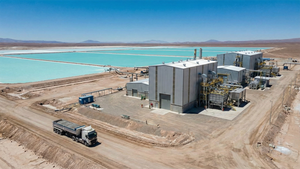TAMPA, Fla., May 24, 2023 (GLOBE NEWSWIRE) -- With hurricane season fast approaching, Verizon’s team is working to ensure its people and assets are ready to be deployed at a moment’s notice to assist with rapid recovery efforts of critical communications infrastructure. Recognized repeatedly for reliability, Verizon’s extreme network is designed to withstand extreme weather and deliver superior service by including redundancy on critical paths and components to avoid potential failures which could significantly affect customers. The use of battery and generator backup systems in critical locations such as cell sites and network operations centers also serve to minimize the risk of disruption if commercial power is lost. One hundred percent of Verizon macro cell sites which provide large area coverage have backup battery power and 79% have backup generators.
But even the most hardened infrastructure can be shaken by mother nature.
In case emergency network recovery becomes necessary after a hurricane makes landfall, Verizon is prepared to respond quickly. Verizon maintains a fleet of over 550 portable assets, including fully functional, generator-powered cell sites that can replace or enhance network coverage and capacity in a given area as well as drones and a fixed wing aircraft that can provide service and situational awareness from the sky above. Additionally, Verizon boasts an industry-leading 200 satellite-based portable network assets.* These satellite assets provide an alternate way to connect cell sites to the rest of the network in the event that a fiber cable is lost due commercial power outages or physical damage. All of these mobile assets are complemented by more than a thousand portable generators and a comprehensive refueling program. These assets are kept in staging areas across the country for rapid deployment, some even being stored in a cave 60’ below ground for safe-keeping.
“Our network is built with industry leading resiliency and reliability. The work we do before the extreme weather moves in is critical in minimizing its impact and speeding the recovery work after the weather has passed,” said Joe Russo, Verizon’s EVP and President, Global Networks and Technology. “We have invested heavily and trained relentlessly to be ready for rapid-recovery scenarios because we know how critical communications services are.”
Prioritizing first responders and mission-critical work
As first responders prepare for hurricane season, the Verizon Frontline Crisis Response Team stands ready to help ensure public safety agencies on the front lines of any potential disaster response operations have the mission-critical communications capabilities they will need to achieve their missions. This team, composed primarily of former first responders and military personnel, is solely dedicated to supporting public safety customers during emergencies at no cost. Verizon Frontline Crisis Response Team members set up portable cell sites, WiFi hotspots, free charging stations and other Verizon Frontline devices and solutions that help enable mission-critical communication and/or boost network performance. They deployed in support of nearly 750 public safety agencies in nearly every state in 2022.
Verizon engineers prioritize recovery efforts after a storm. The first priority is to restore basic voice communication services for search and rescue and mission-critical life saving work. They then prioritize restoration of service for public safety and Emergency Operations Centers that are activated to respond to an emergency, often working with the Verizon Frontline Crisis Response Team to deploy mobile cell sites to provide connectivity in temporary forward command centers. Next, engineers focus on support for utility and community response teams who are restoring commercial power, setting up shelters or providing security escort services. When all emergency response teams have service, engineers quickly get work restoring service throughout the impacted area and remain with the impacted community until full service is at pre-storm levels, often modernizing replacement equipment in the process.
Verizon’s fleet
Verizon’s fleet includes large assets to support mobile workstations and facilities for first responders and the community, a variety of temporary mobile cell sites with standalone power and backhaul connections, and a robust roundup of mobile assets to restore parts of the permanent network infrastructure that could be damaged by storms.
Large assets to support mobile workstations and facilities for first responders and the community
- Tactical/Mobile Command Trailer Command/ Communications for public safety sector
- International 4300 Truck Communications and transport for Hazmat response equipment
- Gooseneck Trailer Work stations and attached shelter for community and public safety support with a satellite-based wifi system.
- Big Red Community outreach big rig vehicle with 24 internet-connected workstations
- Wireless Emergency Command Center (WECC) A mobile communication center with workstations and charging stations open to the public.
- Store on Wheels (SOW) A fully stocked mobile store supplying devices, equipment and technical support
- Tactical/Mobile Command Trailer Command/ Communications mobile center for public safety teams
- Mobile Connectivity Agile Vehicle Remote satellite vehicle able to create eFemto & WiFi networks
- Rapid Response Connectivity Unit Remote vehicle able to provide portable satellite, eFemto, and cradlepoint connections.
- Wireless Routers Router capable of repeating RF signal and creating ad hoc wifi networks for Emergency Operation Centers and forward command units.
Temporary mobile cell sites with standalone power and backhaul connections
- Satellite Pico-cell on Trailer (SPOT) Mobile connectivity trailer (MCT) satellite trailer solution that can deploy eFemtos and/or WiFi to EOCs and first responders.
- Satellite Cell on Light Truck (SAT-COLT) Mobile cell site equipment with onboard masts that also includes satellite equipment
- Cell on Light Truck (COLT) Mobile cell site equipment with onboard masts contained on a truck.
- Business Inclusive Satellite Onboard Nomadic (BISON) Multipurpose trailer that can be deployed as a temporary satellite connection or can serve as a full mobile cell site.
- Cell on Wheels (COW) Trailer based mobile cell site equipment that may or may not have self-contained masts
- Satellite Trailer Universal Design (STUD) Trailer based unit w/1.8m satellite dish capable of functioning as a temporary satellite connection or can serve as a full mobile cell site.
- LTE as a Mobile Asset (LAAMA) Trailer based LTE asset with pop up mast and antennas in a small form factor.
- High Altitude Wireless Kennewhat (HAWK) Tethered drone aircraft capable of lifting eFemto or small cell solution up to 300’ and providing service from the air.
- WiFi on Light Frame (WOLF) Lightweight wifi trailer with short mast to deploy wifi solutions.
- Node on Wheels (NOW) or Small Cell Node of Wheels (SNOW) Trailer based small cell node solution.
- Tactical Humanitarian Operations Response (THOR) Mobile cell site on a tactical vehicle boasting a private core and local MEC, eNB, satellite, multi-purpose solution
- THOR’s Hammer Trailer based equipment that attaches to Thor with expanded node on wheels capabilities
- Matsing Equipment on Wheels (MEOW) Large capacity antenna mounted on a scissor lift that gets paired with Big MAC equipment trailer to handle large capacity events.
- Bi-directional Amplifier Truck (BAT) Cell signal repeater vehicle with mast to repeat cell signal.
- Cell Repeater on Wheels (CROW) Trailer based cellular repeater asset.
Mobile assets to restore parts of the permanent network
- Satellite Trailer Emitting Equipment Remote (STEER) Satellite equipment on a trailer to support restoration of macro cells (temporarily takes the place of fiber to connect cell towers to the rest of the network.)
- Generator on a Truck (GOAT) Large truck mounted generator to support switch commercial power.
- Mobile Central Radio Access Network (CRAN) Mobile trailer/rig with equipment needed to replace or restore a CRAN hub.
- Micro Outdoor Use Satellite Equipment (MOUSE) Small auto-point satellite solution that gets paired with an eFemto or similar solution
- Plug In Generator (PIG) Portable generator on a trailer to restore or provide power.
- Tower on Wheels (TOW) Towable crank up temporary tower.
- Big Multiple Amplifiers Contained Trailer (Big MAC) Trailer based asset containing multiple remote radio heads and base band units.
- UAS/ Drones Smaller drones used for site inspections and assessments
*Based on publicly available information.
MEDIA CONTACT:
Karen Schulz
864-561-1527
Karen.Schulz@Verizonwireless.com






